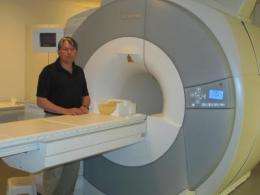Spinal cord processes information just like areas of the brain

Patrick Stroman's work mapping the function and information processing of the spinal cord could improve treatment for spinal cord injuries.
"Basic physiology books describe the spinal cord as a relay system, but it's part of the central nervous system and processes information just like parts of the brain do," explains Dr. Stroman, director of the Queen's MRI Facility and Canada Research Chair in Imaging Physics.
Dr. Stroman's research is directed at precisely mapping the areas above and below a spinal cord injury in order to better determine the precise nature of an injury and the effectiveness of subsequent treatment. When medical research has advanced to a point where clinicians are able to bridge an injury on a spinal cord, Dr. Stroman's spinal mapping technique will be key in accurately pinpointing the injury to be bridged.
The technique involves capturing multiple images of the spinal cord using a conventional MRI system. The image capturing is repeated every few seconds over several minutes. During the imaging temperature sensations on the skin are varied allowing areas of the spinal cord that respond to the temperature changes to be detected in the MRI.
During their research, Dr. Stroman's team was also surprised to discover that levels of attention impact information processing in the spinal cord. By examining the differences in spinal cord functioning in people who were either alert or distracted by a task they were able to see changes in the level of cord activity picked up by the MRI scanner.
"The effect of attention is one of the reasons that when you're playing sports and you get hurt, you often don't become aware of the injury until after the game when your attention and focus changes," says Dr. Stroman. "We already knew that a person's level of attention affects information processing in the brain, but this finding has made us aware that level of attention has to be properly controlled in research that aims to accurately map spinal cord function."
Dr. Stroman's spinal cord mapping research has important implications for those with spinal cord injuries who suffer from chronic pain. The research also applies to any conditions—including multiple sclerosis, fibromyalgia, or congenital conditions—where the function of the spinal cord is affected.














